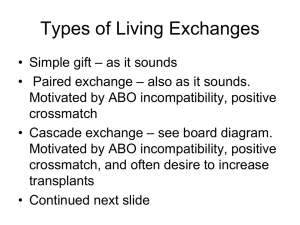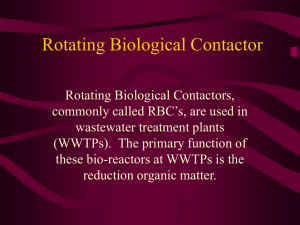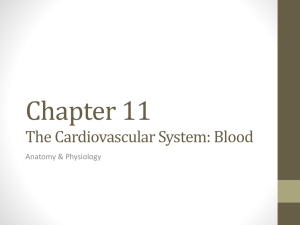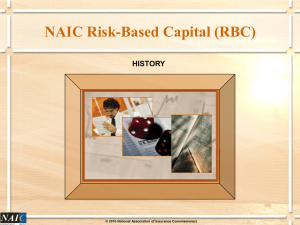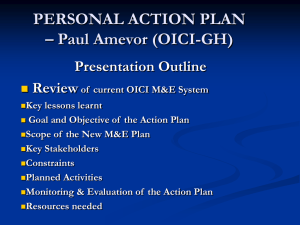R - Virginia Commonwealth University
advertisement
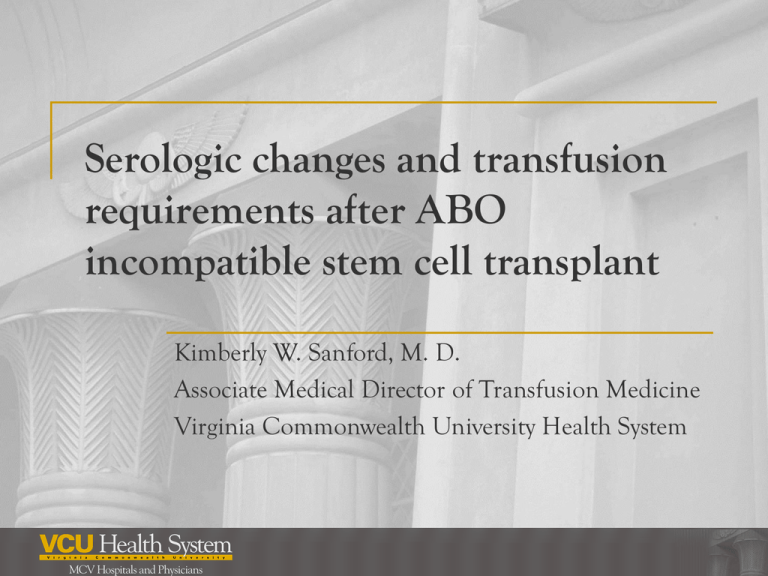
Serologic changes and transfusion requirements after ABO incompatible stem cell transplant Kimberly W. Sanford, M. D. Associate Medical Director of Transfusion Medicine Virginia Commonwealth University Health System Objectives Review basic ABO serology Define the types of incompatible ABO transplants Serologic changes in recipient Discuss transfusion strategies Page 2 Antigen Substance capable of inducing immune response Protein, carbohydrate, lipid Can be cell bound or free floating ANTIGEN RBC Page 3 Antibody A protein synthesized by B lymphocyte in response to antigen and resides in the plasma Expected antibody – Naturally occurring Example Anti A, Anti-B antibodies Unexpected antibody Exposure to donor blood through transfusion Exposure during pregnancy Example: Anti-D, Anti-Kell antibodies Page 4 ABO System The antigens present on the surface of RBC are numerous ABO system Several hundred antigens present on surface A antigen B antigen AB antigen O lacks both A and B antigen RBC Rh system 49 antigens make up the Rh system 5 antigens most important: D, C,E,c,e Page 5 ABO system Group A Group AB Group B Group O Page 6 ABO antibodies RULES: WE FORM ANTIBODIES TO THE ANTIGENS WE LACK WE DO NOT FORM ANTIBODIES TO OUR OWN ANTIGENS Page 7 Blood Group A Patient has A antigen on RBC Patient lacks B antigen Therefore patient will form Anti-B antibodies, but NOT Anti-A antibodies. Page 8 Blood Group B Patient has B antigen on RBC Patient lacks A antigen Therefore patient forms Anti-A antibodies but NOT Anti-B antibodies Page 9 AB group Patient have both A and B antigen on RBC Therefore patient does NOT form any AB antibodies. Page 10 O Blood Group Patient lacks both A and B antigen Patient forms both: Anti-A antibody Anti-B antibody Page 11 HLA & ABO inherited separately HLA: Chromosome 6 (6p21.3) contains 200 genes, expressed on WBC ABO: located on Chromosome 9, expressed on RBC Patient & donor may be 6/6 HLA match but disparate ABO groups Page 12 HLA system Human Leukocyte Antigen system expressed on all nucleated cells Mature circulating RBCs do not have nuclei, do not express HLA antigens Look at HLA antigens to determine if donor is a match Class I: HLA A, B, C Class II: HLA DP, DQ, DR HLA-A, B, DRB1 (Cw) are most important for matching Page 13 HLA and ABO Antigens HLA compatibility Strongest predictor for occurrence of severe GVHD Single most important factor to consider in selecting donor Page 14 ABO mismatch transplant ABO mismatch does not: Affect engraftment since stem cells do not have ABO antigens The lack of the ABO antigens allow for homing and engraftment of stem cells regardless of ABO incompatibility Does NOT affect neutrophil, platelet engraftment, graft failure or rejection. Page 15 ABO mismatched transplants Complications Require more transfusion Acute RBC hemolysis Acute hemolysis of RBC with infusion of HPC product Delayed RBC hemolysis Delayed RBC engraftment or RBC aplasia After engraftment, marrow produces donor RBC incompatible with recipient antibodies. After engraftment, ABO antibodies produced against recipient RBC Patient develops a positive DAT and hemolysis Can be life threatening Complex transfusion requirements Page 16 Intravascular hemolysis Antibody binds intravascular to RBC activating complement Complement causes pores in RBC membrane Free hgb escapes, hgb drops, LDH increases, haptoglobin decreases Complement activation generates Anaphylatoxins, C3a & C5a Proinflammatory cytokines activated Binds NO2 Renal vasoconstriction, ischemia, tubal necrosis, renal failure IL-1, IL-6, IL-8, TNF Fever, Hypotension, Activate WBC and clotting cascade Disseminated Intravascular coagulation Death Page 17 Intravascular Hemolysis Page 18 ABO incompatibilities in transplant Major Minor Recipient has ABO antibodies directed against donor RBC Donor has ABO antibodies directed against recipient RBC Bidirectional: Major and Minor ABO Incompatibility: Recipient has ABO antibodies directed against donor red cells AND Donor has ABO antibodies directed against recipient red cells. Page 19 Major mismatch: O recipient & A donor O recipient: Anti-A, Anti-B antibodies and O RBCs Donor RBCs: A antigen RBC Complications R Immediate hemolysis of donor RBC at transplant R R R D R R R D R R Page 20 Delayed complications Delayed hemolysis after RBC engraftment Persistent recipient anti-A abs Hemolyze donor A RBC produced from marrow. Delay RBC engraftment 120-605 days post transplant 20% of patients experience RBC aplasia (severe) Reticulocytopenia persists > 60 days RBC precursors not present in marrow aspirate Page 21 Minimize Risk Apheresis collections can minimize RBC contamination of product to hematocrit < 2-3%. Remove RBCs from the graft below 10-20 ML during processing of stem cell product Page 22 Minor Mismatch: A recipient & O donor Recipient A : A RBC and Anti-B abs O donor: infusion of Anti-A abs into recipient Complication Delayed hemolysis (1-2 wks) after donor lymphocyte engraftment D R D D D R R R R R Page 23 Minimize Risk Remove donor plasma and antibody from graft to prevent hemolysis at transplant Biggest risk is 5-14 days after transplant, the donor lymphocytes create antibodies against recipient RBC cells. Positive DAT and hemolysis of RBC Severe hemolysis can lead to multisystem organ failure Death Page 24 Passenger donor lymphocytes “Passenger” donor lymphocytes proliferate within the marrow and produce ABO antibodies. R Page 25 Bidirectional Mismatch: A recipient & B donor Recipient: A RBC’s with Anti-B antibodies Donor: B RBC’s with Anti-A antibodies R Complication: immediate hemolysis of donor cells, delayed hemolysis after lymphocyte engraftment of recipient RBC and RBC aplasia D R D D R D R Page 26 Minimize Risk Deplete the donor graft of RBC and plasma. Biggest risk is 5-14 days after transplant, the donor lymphocytes create antibodies against recipient RBC cells. Delayed RBC engraftment, pure RBC aplasia Positive DAT and hemolysis of RBC Can lead to multisystem organ failure Death Bidirectional ABO incompatibility have significantly increased risk of mortality over major and minor incompatibilities Page 27 Transfusion support Difficult to select components Recipient antibodies can persist for weeks or months after transplant and engraftment Donor lymphocytes produce antibodies against recipient RBC Patients are chimeras Patient has 2 distinct blood group RBC populations Donor RBC production increases after engraftment, incompatible with persistent recipient antibody Concerns Intravascular hemolysis in major and bidirectional mismatches Delayed hemolysis in minor mismatches Select product that will not exacerbate hemolysis Transfusion support can affect overall survival Page 28 ABO/Rh incompatible transplant transfusion Phase I: Prior to transplant Phase II: Transplant until engraftment Recipient antibodies are still detectable Chimera: recipient and donor type RBC detectable Front and back types don’t match Interpret as undetermined type Phase III: Complete engraftment Patient RBC type like donor RBCs Patient ABO antibodies are same as donor. Requires confirmed new blood type on 2 separate occasions to switch blood products to donor type Page 29 ABO selection of products Major Incompatibility: O recipient receives A donor PRBC Transfuse with recipient type RBC until recipient antibodies are no longer detectable. Then switch to donor type RBC Plasma Continue with donor type plasma Page 30 ABO Selection of PRBC Major incompatibility: O recipient & A donor Recipient has Anti-A or Anti B antibody against donor A RBC Transfuse with recipient type, O RBC R D Page 31 ABO Selection of Plasma products Major incompatibility: O recipient & A donor Recipient has Anti-A or Anti-B antibody against donor A RBC Transfuse with donor type A plasma R D R Page 32 Transfusion for Major Incompatiblity Recipient Donor RBC/WBCs Platelets/FFP O A O A, AB O B O B, AB A AB A AB B AB B AB O AB O AB Page 33 ABO selection of products Minor Incompatibility: A recipient receives O donor PRBC Transfuse with donor type RBC until engraftment Plasma Continue with recipient type plasma until recipient RBCs are no longer detectable, then switch to donor type Page 34 Minor Mismatch: A recipient & O donor RBC: provide donor type O RBC start immediately after transplant and continue after engraftment. Page 35 Minor Mismatch: A recipient & O donor Plasma: provide recipient type A or AB plasma until recipient red blood cells are no longer detected, then switch to donor type plasma. Page 36 Minor ABO Incompatibility Recipient Donor RBC/WBCs Platelets/FFP A O O A, AB B O O B, AB AB O O AB AB A A AB AB B B AB Page 37 Bidirectional Mismatch: A recipient & B donor Bidirectional Incompatibility PRBC R Provide O PRBC FFP Provide AB plasma products D R D D R D R Page 38 Bidirectional (Major and Minor) ABO Incompatibility Continue until offending RBC antigens and antibodies are no longer detected. Recipient Donor RBC/WBCs Platelets/FFP B A O AB A B O AB Page 39 RBC Alloantibody incompatibility Have major and minor incompatibilities of other antigens Rh system: Anti- D, C, E Anti – Kell or Kidd abs are particularly bad Major: Recipient has antibodies to donor antigens Minor: Donor has antibodies to recipient RBC antigen Ex: Kell antigen + donor, recipient with Anti-Kell abs Ex: donor with Anti-E abs, E antigen + recipient HPC product Keep low hct during collection Remove plasma from HPC product Provide antigen negative, crossmatch compatible RBC for transfusion. Page 40 Alloimmunization to RBC antigens Despite immunosuppression, may still see immune response to foreign RBC antigens. Complicates transfusion by now requiring antigen negative blood in addition to ABO transfusion requirements. 2 studies have demonstrated red cell alloimmunization of 2-8% in patients undergoing stem cell transplant. Perseghin P, Balduzzi A, Galimberti et al. Bone Marrow Transplant 2003;32:231-6. Abou-Elella AA, Camarillo TA, Allen MB et al. Transfusion 1995;35:931-5. Page 41 Rh Negative Transplant patients Minimize exposure to Rh positive products Rh positive platelets contain about 2 ml of RBC/dose Risk of forming Anti-D is low, 0-22% 22 adult patients, none alloimmunized 35 pediatric patients, none alloimmunized Cid J, Ortin X, Elies E, et al. Transfusion 2002;42:173-6.patients Molnar R, Johnson R, Sweat LT, Geiger TL. Transfusion 2002;42:177-82. 98 adult patients, received 445 D+ RBC units 22 formed anti-D, 22% Yazer MH, Triulzi DJ. Transfusion 2007;47:2179-2201. Page 42 Rh Incompatible Transplants Recipient Donor Transfusion Protocol Rh Positive Rh Negative Rh Negative cells Rh Negative Rh Positive Transfuse Rh Negative red cells; switch to Rh positive cells once the transplanted BM or PBSC begins producing Rh Positive red cells Page 43 Summary Complex transfusion requirements See acute and delayed hemolysis Lower overall survival in minor and bidirectional mismatched grafts. Delayed RBC engraftment or red blood cell aplasia. ABO doesn’t affect engraftment of stem cell product, lymphocytes or granuloctyes Studies have found ABO incompatibility bigger risk of mortality in certain cases: based on disease condition reduced intensity conditioning receiving unrelated grafts. Page 44 References Szczepiorkowski ZM. Transfusion Support for Heamotpoietic Transplant Recipients. In: Roback J. Ed. Technical manual 16th ed. Bethesda MD: American Association of Blood Banks, 2008. 679-96. Tormey CA, Synder EL. Transfusion Support for the Oncology Patient. In: Toby L. Simon et al. Ed. Rossi’s Priniciples of Transfusion Medicine 4th ed. American Association of Blood Banks, 2008. 482-97. Perseghin P, Balduzzi A, Galimberti et al.Red blood cell support and alloimmunization rate against erythrocyte antigens in patients undergoing hematopoietic stem cell transplantation. Bone Marrow Transplant 2003;32:231-6. Abou-Elella AA, Camarillo TA, Allen MB et al. Low incidence of red cell and HLA antibody formation by bone marrow transplant patients. Transfusion 1995;35:931-5. Page 45
